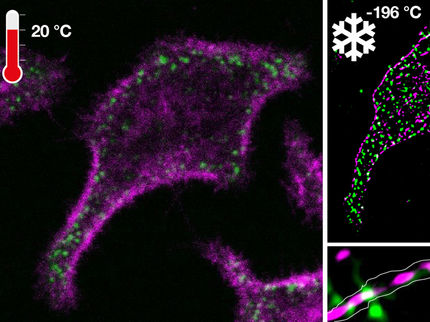Promega and Leica Microsystems Sign Agreement to Develop Fluorescent Ligands Enabling Live Cell Imaging at the Sub 100 nm Range
Promega Corp. announced that it has signed an agreement with Leica Microsystems to enable fluorescent imaging of proteins in live cells. Under the terms of the agreement, Promega will develop fluorescent ligands for its HaloTag fusion proteins, that will be used to label proteins within live cells so that they can be visualized with Leica's TCS STED (stimulated emission depletion) superresolution microscope. Developed in the laboratory of Dr. Stefan Hell of the Max-Planck Institute in Germany, STED microscopy enables the investigation of structural details below the 100nm range.
Commonly used fluorescent proteins such as GFP are not optimal for use with high-powered STED technology as they are prone to photobleaching and lack appropriate spectral properties. In addition, alternative methods of labeling proteins with fluorescent antibodies are only applicable for fixed cells. Therefore, the agreement between Promega and Leica Microsystems will enable imaging of proteins within live cells at sub 100nm range.
Promega has been working with Leica Microsystems since 2006 to develop novel ways to label proteins within cells using its proprietary HaloTag® technology.
Most read news
Topics
Organizations
Other news from the department business & finance

Get the life science industry in your inbox
By submitting this form you agree that LUMITOS AG will send you the newsletter(s) selected above by email. Your data will not be passed on to third parties. Your data will be stored and processed in accordance with our data protection regulations. LUMITOS may contact you by email for the purpose of advertising or market and opinion surveys. You can revoke your consent at any time without giving reasons to LUMITOS AG, Ernst-Augustin-Str. 2, 12489 Berlin, Germany or by e-mail at revoke@lumitos.com with effect for the future. In addition, each email contains a link to unsubscribe from the corresponding newsletter.
Most read news
More news from our other portals
See the theme worlds for related content
Topic world Antibodies
Antibodies are specialized molecules of our immune system that can specifically recognize and neutralize pathogens or foreign substances. Antibody research in biotech and pharma has recognized this natural defense potential and is working intensively to make it therapeutically useful. From monoclonal antibodies used against cancer or autoimmune diseases to antibody-drug conjugates that specifically transport drugs to disease cells - the possibilities are enormous

Topic world Antibodies
Antibodies are specialized molecules of our immune system that can specifically recognize and neutralize pathogens or foreign substances. Antibody research in biotech and pharma has recognized this natural defense potential and is working intensively to make it therapeutically useful. From monoclonal antibodies used against cancer or autoimmune diseases to antibody-drug conjugates that specifically transport drugs to disease cells - the possibilities are enormous
Topic World Cell Analysis
Cell analyse advanced method allows us to explore and understand cells in their many facets. From single cell analysis to flow cytometry and imaging technology, cell analysis provides us with valuable insights into the structure, function and interaction of cells. Whether in medicine, biological research or pharmacology, cell analysis is revolutionizing our understanding of disease, development and treatment options.

Topic World Cell Analysis
Cell analyse advanced method allows us to explore and understand cells in their many facets. From single cell analysis to flow cytometry and imaging technology, cell analysis provides us with valuable insights into the structure, function and interaction of cells. Whether in medicine, biological research or pharmacology, cell analysis is revolutionizing our understanding of disease, development and treatment options.
Last viewed contents
Prion disease detected soon after infection and in surprising place in mouse brains





















































